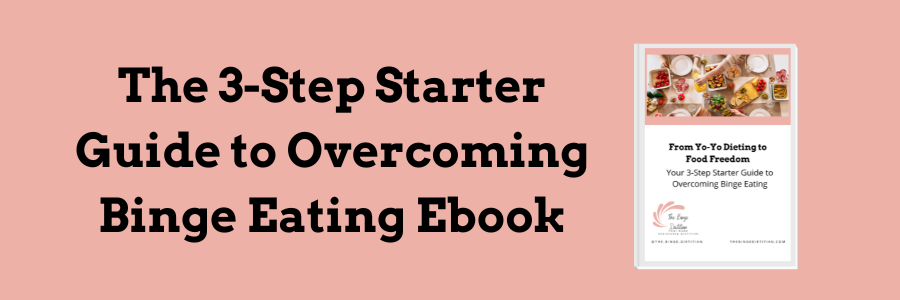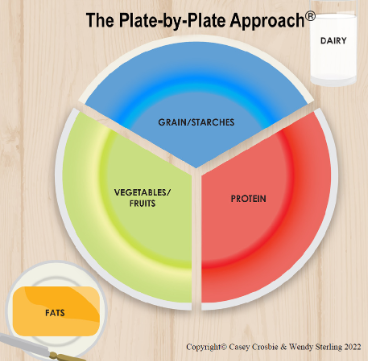Understanding “Normal” Eating Habits
[Blog written by Toni for The BED Blog Post - The Binge Eating Recovery Blog].
One of the most common questions I get as a dietitian is, “What does a ‘normal’ meal, snack, or eating pattern look like?” Many people, especially those who’ve struggled with binge eating and maybe relate to “trying all the diets” or experienced yo-yo dieting, often feel confused about what constitutes a “normal” portion size or a “normal” way to eat. This confusion is entirely understandable.
Let’s take a look at what "normal" eating looks like and provide guidance to help you feel more confident and less anxious about your eating patterns.
Relearning How to Eat Normally
Years of dieting distort our understanding of food, portions, and hunger cues, making it hard to trust your body. Diet culture promotes restrictive and unsustainable eating patterns, now normalised in society. Conflicting diet messages and beauty standards pushing thinness create confusion about what is "normal."
This all leads to a cycle of restriction and binge eating. Restrictive diets fail long-term and disconnect people from hunger cues, hinder emotional processing, and reduce self-care, increasing the risk of binge eating.
Understanding Normal Eating
A “normal way to eat” can look different from person to person but the general gist is that food is flexible and varies from person to person. It’s where food is enjoyable and meets your body’s needs and wants without restriction, preoccupation, or obsession with food.
It's important to mention that a “normal” way to eat is far from “perfect”. It's okay if some days look different from others but the idea of eating ‘perfectly’ will feed into an all-or-nothing mindset and contribute to binge eating.
Here are some general principles to consider that can help guide you towards a more balanced and sustainable way of eating:
Regular Eating
This might look like three meals and two to three snacks per day - depending on your lifestyle. If you struggle with a regular intake, it might help to work with a dietitian to find out what is a sustainable way to eat for you.
Eating regularly can help maintain steady energy levels, and blood glucose levels but most importantly prevent extreme hunger and cravings, which often lead to binge eating.
Consistency of eating is key and usually a first step in binge eating recovery as it helps you reconnect with your hunger and fullness cues and start being curious (and non-judgemental!!) about what your body is craving.
Variety and Balance
A normal eating pattern includes a variety of foods from all food groups. This means incorporating a mix of carbohydrates, proteins, fats, and plenty of fruits and vegetables into your meals.
I love sharing “The Plate-by-Plate Approach” with my clients because it uses a visual effect to support eating habits rather than focusing on tracking calories or following a meal plan. A good place to start is the ⅓ plate model:
Each food group provides essential nutrients for optimal body function. Including all food groups in every meal supports health, increases fullness, reduces cravings, and helps prevent binge eating. Let's discuss the benefits of each component:
Grain/Starches (⅓ of your plate or bowl):
You might know these as carbs, starchy carbohydrates or complex carbohydrates. Diet culture messaging paints carbohydrates as the villain when infact the body loves and thrives off these because they are our body's preferred source of energy.
Include ONE portion of these at each meal:
Pasta
Bread (2-4 slices)
Rice/Cous Cous/Quinoa
Potatoes
½ a cup of cereal
½ cup of oats.
Including these at each meal is ‘normal’, despite everything you’ve been told by diet culture. I find that people I work with do have a lot of fear, worry or stress around these foods which leads them to limit or completely avoid starchy carbohydrates at meal times.
Protein (⅓ of your plate or bowl):
These are important to help rebuild and maintain muscle.
Include ONE portion of these at each meal:
Meat (beef/pork/turkey/chicken)
Fish
2 eggs
Vegan proteins like tofu, soya meat, lentils, beans and chickpeas.
Protein is a nutrient much promoted at the moment. In my opinion, although they are a really important nutrient, I feel like it’s overhyped and a new marketing ploy. It’s important to include these at each meal will also help you to stay fuller for longer.
Fruits or Vegetables (⅓ of your plate or bowl):
Fruits and vegetables contain lots of different vitamins and minerals which help keep all parts of the body healthy. They are high in fibre so a variety of these daily will support you to poo regularly, but the fibre helps with feeling fuller for longer.
Fats (one portion at each meal):
Again, like carbohydrates, fats have had a lot of bad press in the past, especially back in the ’80s, ’90s and early 2000s. A lot of people I work with have a lot of fear around these foods and it is important to be ‘mindful’ of how much fat you have.
Including one portion of fat at meal times helps make your meals tasty helping you to feel more fulfilled with your meal. Then many parts of our body benefit from eating these such as the skin, hair and nails but also fats are important for hormone regulation and absorption of fat-soluble vitamins.
Include a minimum of ONE of these (or a combination) with every meal:
Cook in vegetable oil or add extra virgin olive oil
Adding butter to bread/toast
½ small avocado
1 tablespoon nut butter or tahini
1 tablespoon seeds
It’s very “normal” to include more than one of these at each meal, for example, you might fry your eggs in oil and then add avocado to your toast. The goal is to include some fats at each meal.
Dairy (3 portions a day - as a minimum):
You need 3 portions of dairy a day to meet your calcium requirements which helps to keep your bones strong and reduce the risk of osteoporosis later in life. If you’re going through menopause, you may need more or to use supplements (seek advice from a healthcare professional or dietitian about this).
Include a minimum of 3 of these daily:
Adding milk to cereal/oats (if using plant-based milk, make sure they are fortified with calcium).
Having a ⅓ of a pint glass of milk with your meal/snacks
Adding a ‘thumb’ sized amount of cheese to meals/snacks
Adding cream to pasta dishes
Having a yogurt or rice pudding for a snack
Having a milky coffee or hot chocolate
A Note on “Perfectionism”
“Perfectionism” is a common trait in people with binge eating and it can be a significant barrier to developing a healthy relationship with food. Striving for the “perfect” diet often leads to unrealistic expectations and unnecessary stress, which can trigger binge eating episodes when those standards aren't met. This all-or-nothing mindset makes it harder to listen to and trust your body's needs.
Eating normally means understanding that there's no such thing as a perfect diet. It's about nourishing your body in a way that feels right for you, without the pressure of achieving an unattainable ideal. Some days will look different from others, you might not always have that balanced plate and that's okay.
It’s less about ‘normal’ and more about nourishment
Understanding normal eating habits is essential for anyone looking to break free from the cycle of dieting and binge eating. By focusing on regular meals and snacks, incorporating a variety of foods from all food groups, and breaking free from restrictive diet culture, you can start to rebuild a healthier relationship with food. Remember, normal eating is about being flexible with food and finding a balanced, sustainable way of eating that nourishes your body and mind without preoccupation or guilt.
STRUGGLING WITH DIETING & BINGE EATING?
Managing binge eating disorder can be a challenging journey, but you don't have to go through it alone.
Learn more about my 1:1 consultations and how they can empower you to break free from dieting and binge eating. Click here to explore my support services
Don't let dieting and binge eating control your life any longer. Contact me here to find out how I can support you.
My Mission: Embracing a balanced and sustainable approach
At The Binge Dietitian, my mission is simple yet powerful: to help yo-yo dieters liberate themselves from binge eating and find lasting peace with food. I am passionate about guiding you towards a healthier relationship with both your body and the food you consume. Together, we will set sustainable and realistic goals that support your overall well-being.








